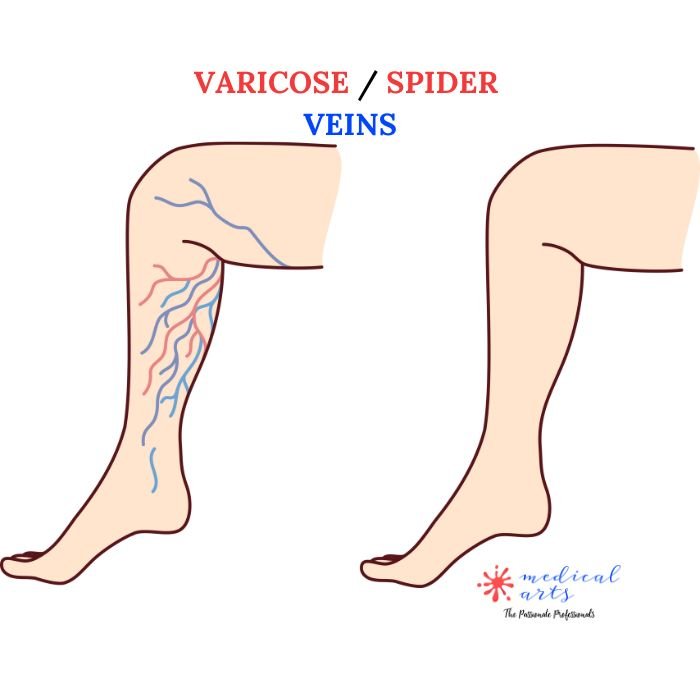Spider veins also known as Varicose veins
Legs are a common location for varicose veins, which are enlarged, swollen, and twisted veins. They are brought on by a defect in the system of valves that regulates blood flow in the veins, which allows blood to flow backward and pool in the veins. Swelling, pain, and a weighted sensation in the legs may result from this. Up to 20% of adults are affected by varicose veins, which are more common in women, older people, and people who spend a lot of time standing. Although varicose veins are typically not dangerous, they can occasionally cause pain, skin changes, and complications like blood clots and skin ulcers. Compression stockings, medical procedures, and lifestyle modifications are all possible varicose vein treatments.
Symptoms of Varicose Veins:
- Swelling in the legs
- Aching or heavy feeling in the legs
- Cramping or throbbing in the legs
- Burning or itching of the skin over the veins
- Pain after standing or sitting for long periods
Causes of Varicose Veins:
- Age: The veins lose their elasticity over time, making them more susceptible to becoming varicose.
- Genetics: Some people have a family history of varicose veins, suggesting a genetic predisposition to the condition.
- Hormonal changes: such as pregnancy or menopause, can weaken veins and cause varicosities.
- Obesity: Being overweight can put extra pressure on the veins in the legs.
- Prolonged standing or sitting: This can increase the pressure in the veins and cause blood to pool.
Risk Factors for Varicose Veins:
- Family history of varicose veins
- Age over 50
- Female gender
- Pregnancy
- Obesity
- Prolonged standing or sitting
While these are the most common causes and risk factors, it's essential to consult a doctor to get a proper diagnosis and determine the best course of treatment.
Diagnosis of Varicose Veins:
A doctor can usually diagnose varicose veins based on a physical examination of the legs and a medical history. In some cases, additional tests may be ordered to confirm the diagnosis, such as an ultrasound or venography.
Treatment of Varicose Veins:
There are several options for treating varicose veins, ranging from lifestyle changes to medical procedures. The choice of treatment depends on the severity of the veins and the symptoms experienced by the patient.
Lifestyle Changes:
- Exercise regularly
- Maintain a healthy weight
- Avoid standing or sitting for long periods of time
- Wear compression stockings
Medical Procedures:
- Sclerotherapy: A solution is injected into the vein to cause it to shrink and fade.
- Endovenous laser treatment (EVLT): A laser fiber is inserted into the vein to heat and seal it closed.
- Radiofrequency closure: A catheter delivers radiofrequency energy to heat and shrink the vein.
- Vein stripping: An invasive surgical procedure in which the vein is removed through small incisions.
Naturopathic remedies for Varicose Veins:
Naturopathy and home remedies can be used to help relieve the symptoms of varicose veins and improve overall vein health. However, it's important to keep in mind that these remedies may not be suitable for everyone and should not be used as a substitute for medical treatment.
- Horse chestnut extract: Horse chestnut extract has been shown to improve blood circulation and reduce swelling in the legs.
- Butcher's broom: Butcher's broom is a herb that has been used to improve circulation and reduce swelling in the legs.
- Vitamin C: Vitamin C is essential for the production of collagen, which helps keep veins healthy.
- Vitamin E: Vitamin E helps to reduce inflammation and improve blood flow.
Home Remedies for Varicose Veins:
- Elevation: Elevating the legs above the heart can help improve blood flow and reduce swelling.
- Exercise: Regular exercise, such as walking or swimming, can help improve circulation and strengthen the muscles that support the veins.
- Compression stockings: Compression stockings can help improve circulation and reduce swelling in the legs.
- Healthy diet: A diet rich in fiber, antioxidants, and anti-inflammatory nutrients can help improve vein health.
It's important to consult a doctor before starting any new treatment, especially if you have underlying health conditions or are taking medication. Some remedies may interact with medication or worsen existing health conditions.
This video and article is for entertainment and educational purposes only!!


Comentario (1)
Normal veins blood flow